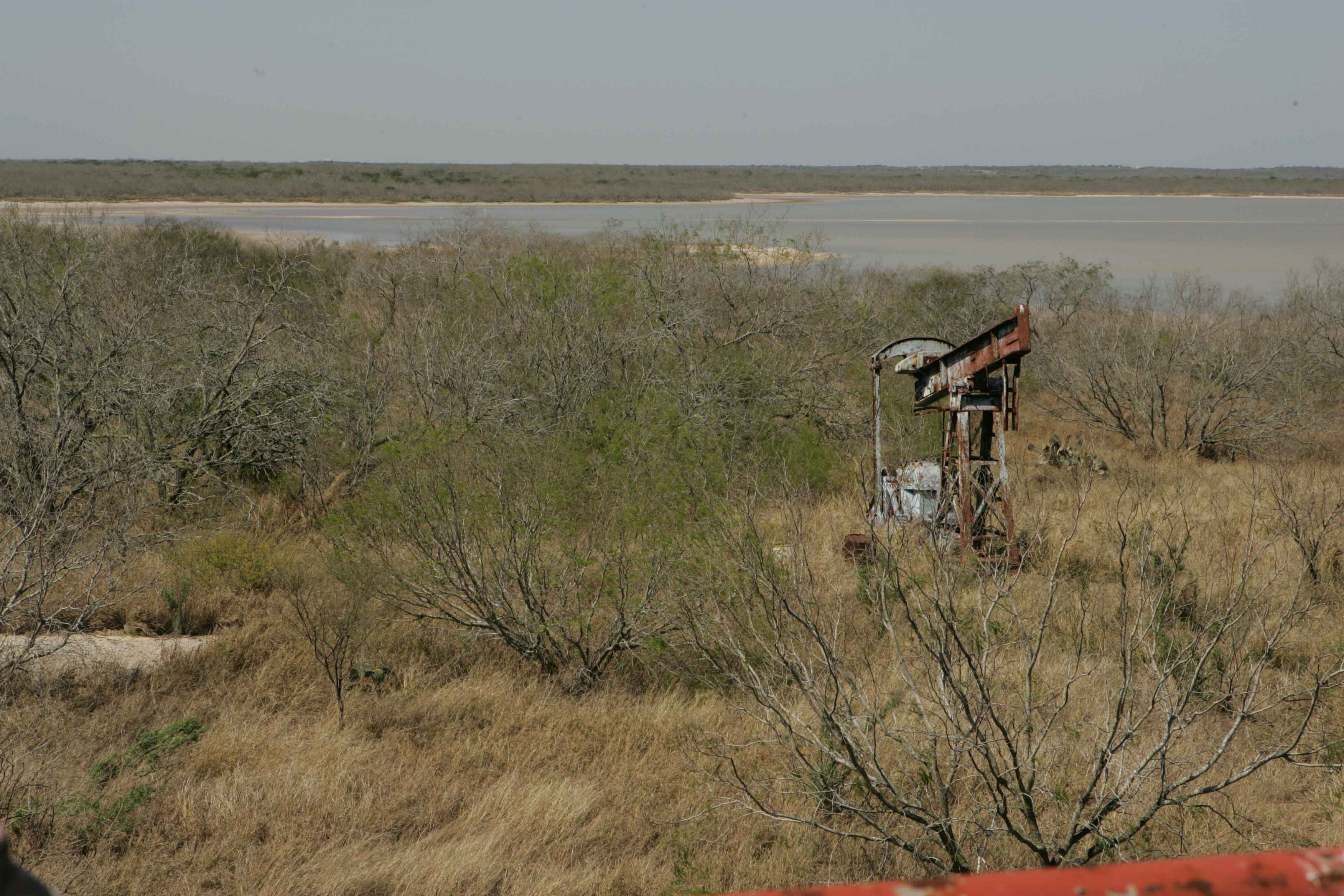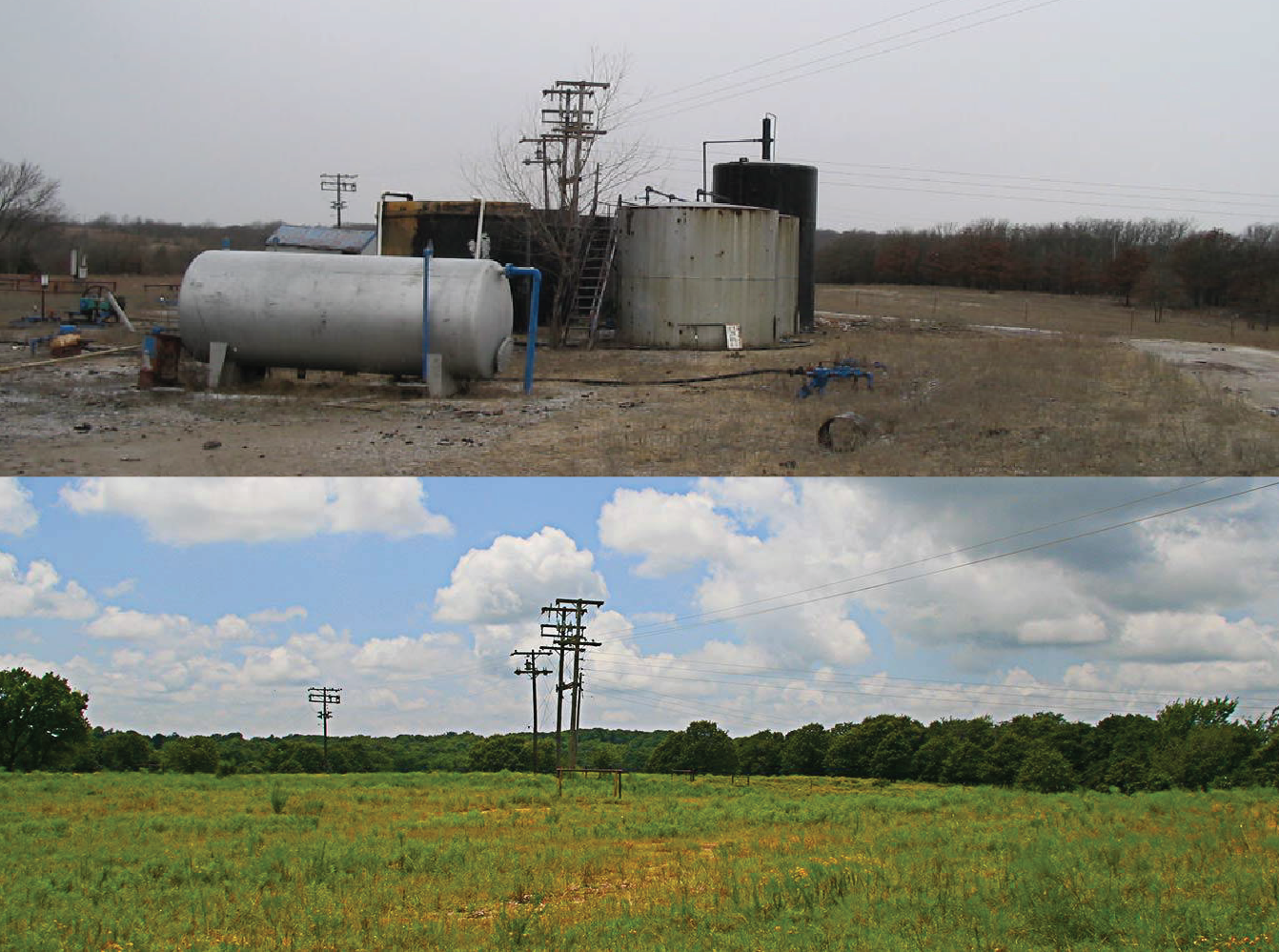What happens to oil and gas wells when they are no longer productive?
Introduction
In 2017, there were one million active oil and gas wells in the United States.1 When a well reaches the end of its productive life, or if it fails to find economic quantities of oil or gas, the well operator is required by regulators to remove all equipment and plug the well to prevent leaks.2 Usually, cement is pumped into the well to fill at least the top and bottom portions of the well and any parts where oil, gas, or water may leak into or out of the well. This generally prevents contamination of groundwater and leaks at the surface. State or federal regulators define specific plugging procedures depending on the local conditions and risks, and may monitor the plugging operation.
However, there are many cases in which wells are not properly plugged before being abandoned, especially if the well operator goes bankrupt, leaving its wells “orphaned”.3 This is more common when oil prices fall rapidly, making many wells uneconomical, as in the 1980s oil glut, the 2008 financial crisis, and the 2014 downturn.
In the late 1980s, the U.S. Environmental Protection Agency estimated that 200,000 of 1.2 million abandoned wells may not have been properly plugged.4 Since then, tens of thousands of orphaned wells have been plugged by state and federal regulators, as well as some voluntary industry programs. These efforts are ongoing, and many orphaned wells have yet to be properly plugged. The exact number is not known: some 3.7 million wells have been drilled in the U.S. since 1859,6 and their history is not always well documented. Older wells, especially those drilled before the 1950s, are particularly likely to have been improperly abandoned and poorly documented.
Inoperable pumpjack at an abandoned well in Texas. Image credit: Steve Hillebrand, U.S. Fish and Wildlife Service.5
Risks to Groundwater, Air, and the Surface Environment
Orphaned wells are often abandoned without any plugging or cleanup, but even plugged wells may leak, especially those plugged in the past, when plugging procedures were less rigorous and used less durable materials. Unplugged or poorly plugged wells may affect:
- Groundwater – old wells may have degraded well casing or cement that can allow oil, gas, or salty water to leak into freshwater aquifers. An assessment of 185 groundwater contamination incidents in Ohio from 1983 to 2007 found 41 incidents caused by leakage from orphaned wells, compared to 113 incidents caused during drilling and production.7
- Methane emissions – a study of 138 abandoned wells in Wyoming, Colorado, Utah, and Ohio found that over 40% of unplugged wells leaked methane, compared to less than 1% of plugged wells. This study estimated that abandoned wells account for 2-4% of the methane emissions from oil and gas activity.8
- The surface environment – orphaned sites may still have old equipment, contaminated soil from small spills, and other waste at the surface. In some unplugged or poorly plugged wells, oil, gas, drilling mud, or salty water can rise up the well and spill at the ground surface or, in the case of offshore wells, into open water.9
Abandoned Wells and Hydraulic Fracturing
Hydraulic fracturing uses the high-pressure injection of fluids into oil- or gas-bearing rocks to fracture them and allow oil and/or gas to flow out. The increased pressure in the rocks during this process can push oil or salty water up nearby unidentified or improperly plugged abandoned wells. In one of the more extreme cases of this, the U.S. Environmental Protection Agency cited an abandoned well in Tioga county, Pennsylvania, that produced a 30-foot geyser of brine for more than a week as a result of hydraulic fracturing of a nearby well.10 In addition to these fluids contaminating soil and potentially reaching groundwater, the unexpected pressure release caused by this fluid escape reduces the effectiveness of the hydraulic fracturing operation, so there are both environmental and economic incentives to identify and plug wells near a planned hydraulic fracturing operation.
Abandoned Well Plugging Campaigns
For several decades, states have increased enforcement of plugging and cleanup requirements. States generally require a performance bond or other financial assurance from the operator that a well will be plugged and the well site restored. However, bond amounts may not meet the plugging and cleanup expenses if an operator goes bankrupt.11 Most states therefore collect fees or a production surcharge from operators specifically for remediation of orphaned wells and associated surface equipment.12 For example, Pennsylvania adds an orphaned well surcharge to drilling permit application fees,14 while Texas adds a 5/8-cent Oil Field Cleanup surcharge to the state’s 4.6% oil production tax.15 The Oklahoma Energy Resources Board remediates abandoned well sites using voluntary industry contributions amounting to 0.1% of oil and gas sales.16
An abandoned well site in Oklahoma before (top) and after (bottom) being remediated. Image credit: Courtesy of the Oklahoma Energy Resources Board.13
Examples of Plugging Programs
- From 1984 to 2008, the Railroad Commission of Texas (RRC, the state’s regulatory agency for oil and gas) plugged almost 35,000 orphaned wells, including offshore wells, at a cost of over $163 million.17 In fiscal year 2017, the RRC plugged 918 orphaned wells at a cost of over $11.6 million.18 As of December 2017, there were roughly 10,000 known orphaned wells in Texas that required plugging; the RRC aims to plug 1,500 of these in fiscal year 2018.19
- From 1989 to 2017, the Pennsylvania Well Plugging Program plugged over 3,000 orphaned wells.20
- The voluntary Oklahoma program mentioned above has cleaned up and restored 15,000 orphaned and abandoned well sites in Oklahoma since 1994 at a cost of almost $100 million.21
- California has plugged more than 1,350 orphan wells since 1977 at a cost of over $27 million. In 2016, many wells remained to be plugged, including about 900 in the city of Los Angeles. The California Department of Conservation is authorized to spend $1 million per year to remediate orphan wells.22
- The U.S. Bureau of Land Management (BLM) reclaimed 295 orphaned well sites in ten states from 1988 to 2009 at a cost of $3.8 million. As of 2010, BLM estimated that there were 144 orphan wells yet to be reclaimed in seven states.23
References
1 U.S. Energy Information Administration – U.S. Oil and Natural Gas Wells by Production Rate.
2 National Petroleum Council (2011). Plugging and Abandonment of Oil and Gas Wells. In: Prudent Development: Realizing the Potential of North America’s Abundant Natural Gas and Oil Resources, Topic Paper #2-25.
3 Orphan Well Association – Frequently Asked Questions.
4 U.S. General Accounting Office (1989). Drinking Water: Safeguards Are Not Preventing Contamination from Injected Oil and Gas Wastes. GAO/RCED-89-97.
5 Image source: https://pixnio.com/miscellaneous/abandoned-gas-well-pump
6 Brandt, A.R. et al. (2014). Methane Leaks from North American Natural Gas Systems. Science, 343, 733-735.
7 Ground Water Protection Council (2011). State Oil and Gas Agency Groundwater Investigations and Their Role in Advancing Regulatory Reforms – A Two-State Review: Ohio and Texas.
8 Townsend-Small, A. et al. (2016). Emissions of coalbed and natural gas methane from abandoned oil and gas wells in the United States. Geophys. Res. Lett., 43, 2283-2290.
9 “Well near Berthoud starts spilling drilling mud 33 years after it was capped.” P. Johnson, Denver Post, October 31, 2017.
10 U.S. Environmental Protection Agency (2016). Hydraulic Fracturing for Oil and Gas: Impacts from the Hydraulic Fracturing Water Cycle on Drinking Water Resources in the United States.
11 Interstate Oil & Gas Compact Commission (2016). State Financial Assurance Requirements.
12 Interstate Oil & Gas Compact Commission – State orphaned and abandoned well programs.
13 Oklahoma Energy Resources Board – Well Site Clean Up.
14 Pennsylvania Department of Environmental Protection (2017). Abandoned and Orphan Oil and Gas Wells and the Well Plugging Program. Fact Sheet 8000-FS-DEP1670.
15 Texas Comptroller – Crude Oil Production Tax.
16 Oklahoma Energy Resources Board – Funding.
17 Interstate Oil & Gas Compact Commission (2009). Orphaned and Abandoned Wells: Innovative Solutions. Groundwork, October 2009.
18 Texas Railroad Commission (2017). Monthly Report of State-funded Well Plugging Activities, August 2017, FY 2017.
19 Texas Railroad Commission (2017). Monthly Report of State-funded Well Plugging Activities, December 2017, FY 2018.
20 Pennsylvania Department of Environmental Protection – 2016 Oil and Gas Annual Report.
21 Oklahoma Energy Resources Board – Restoring Oklahoma’s Land.
22 “Orphan Oil Wells in L.A. Neighborhood to be Permanently Sealed.” California Department of Conservation press release, June 8, 2016.
23 U.S. Government Accountability Office (2011). Oil and Gas Bonds: BLM Needs a Comprehensive Strategy to Better Manage Potential Oil and Gas Well Liability. GAO-11-292.
Petroleum and the Environment
Download a full PDF of Petroleum and the Environment (free) or purchase a printed version ($19.99).
Other parts in this series:
1. Petroleum and the Environment: an Introduction
2. Water in the Oil and Gas Industry
3. Induced Seismicity from Oil and Gas Operations
4. Water Sources for Hydraulic Fracturing
5. Using Produced Water
6. Groundwater Protection in Oil and Gas Production
7. Abandoned Wells
8. What Determines the Location of a Well?
9. Land Use in the Oil and Gas Industry
10. The Pinedale Gas Field, Wyoming
11. Heavy Oil
12. Oil and Gas in the U.S. Arctic
13. Offshore Oil and Gas
14. Spills in Oil and Natural Gas Fields
15. Transportation of Oil, Gas, and Refined Products
16. Oil Refining and Gas Processing
17. Non-Fuel Products of Oil and Gas
18. Air Quality Impacts of Oil and Gas
19. Methane Emissions in the Oil and Gas Industry
20. Mitigating and Regulating Methane Emissions
21. Regulation of Oil and Gas Operations
22. Health and Safety in Oil and Gas Extraction
23. Subsurface Data in the Oil and Gas Industry
24. Geoscientists in Petroleum and the Environment
Glossary of Terms
References


